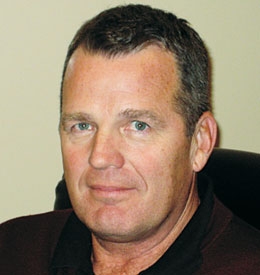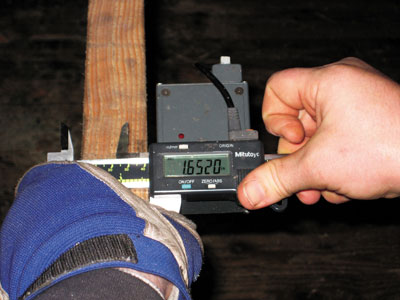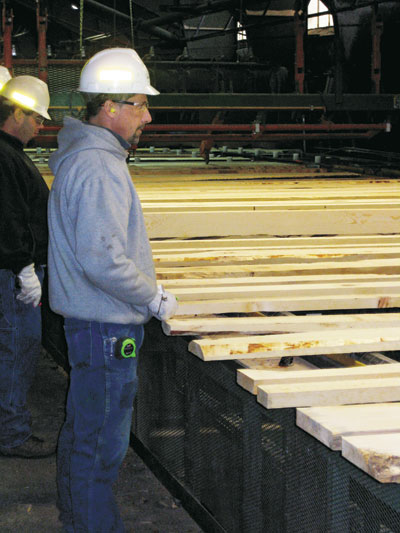
Features
Mills
Sawmilling
Mind the Gap
The Collins Companies, headquartered in Portland, OR, has been a family-owned business since 1855. Throughout the years they have grown their wood products business to include softwood and hardwood lumber, particleboard, as well as hardboard trim and siding. Their softwood sawmill in Chester, CA, has been operating since 1943, and like many others in the industry has experienced good and difficult times. It produces 100 million bdft annually, focusing on high-value products, with a mix of ponderosa pine, sugar pine and white fir.
November 28, 2011 By Cheryl Quinn
 Collins’ President Eric Schooler. The Collins Companies
Collins’ President Eric Schooler. The Collins CompaniesThe mill was totally rebuilt in 2002. After running with the upgraded equipment for several years, there was some frustration that operating performance was not where it needed to be. The mill’s strategy was established, the right assets were in place, now it was time to focus on execution.
At the corporate level there was a sense, and some analytical evidence, that there were significant opportunities for operational improvement at Chester. While the magnitude of the opportunity was not agreed to by all at the mill level, there was certainly a strong desire to see mill performance improve. Late in 2006, the local attitude was “just because the lumber market is going to experience a prolonged downturn, we don’t have to go down with it. Let’s not point fingers, let’s just get this figured out and get better.” So in January 2007, Collins Pine hired Perforex, a Pöyry company, to conduct a two-week assessment of their lumber operations.
Typical of such assessments, the findings were a mix of issues the group was already aware of, but did not know the financial implications, and several items that were not even on the radar. Areas of opportunity that were identified included: log merchandising accuracy, sawmill predictability, optimization strategy, lumber size control, grade and trim accuracy, manufacturing defects, sawmill and planer efficiency, and maintenance. All told, these opportunities totalled a targeted financial opportunity of $40 per thousand.
As in many organizations, the root cause for many of these issues was a lack of formal management systems – it was not a lack of will on anybody’s part. Liz Steffen, internal project co-ordinator says, “The mill did not have a lot of formal structure. Things were done a certain way simply because that was the way they were always done.”
“Things” like focusing on standard lumber operation performance metrics such as board feet per hour, grade out and yield. Results were reviewed and corrective actions were driven by the best efforts of individuals, but did not have the systematic presence, focus or followup that effective performance management requires.
Along with providing details on the specific issues impacting operational and financial performance, the assessment provided an objective view regarding the size of the gap, and generated mill-level support for doing something about it. Eric Schooler, president and CEO of The Collins Companies explains that “The initial study and analysis of operations indicated we were operating lower than potential. The staff felt we were much closer to potential. Our company view of potential was not bought into by the local staff. When they saw the Perforex opportunity numbers, they first resisted their validity but eventually understood and agreed to the potential. That is part of the magic! Once they felt it was possible, they were able to focus on achieving the new potential. The ‘4 minute mile’ magic!”
Getting It Done
Identifying opportunities is one thing; capturing and sustaining them is the real challenge. The local management team knew that doing the same things and expecting significantly different results was not realistic. They partnered with Perforex for assistance in developing and implementing management systems that would facilitate consistent identification of performance issues, understanding of root causes, development of action plans, and tracking of progress. This was not an easy decision in poor markets.
“Perforex was our best consultant/coach option because they understand our business,” Schooler explains. “But the real ‘go, no go decision’ was determining whether to pay Perforex to help us get it done, or try to get the same improvements via Collins staff at Chester or within the company. We decided the Chester staff had been trying to get the job done, and it would either take much longer or not happen at all if we continued on our own. The Perforex route would get the results faster.”
As for markets, he adds, “Improvements from grade recovery and overrun go to the bottom line in good and bad markets. The projected and ultimately realized improvements would and have paid the bills.”
An 11-month project followed to design and implement formal systems to manage quality, value, recovery and productivity in the sawmill and planer mill. A few specific highlights include:
On-Size

A systematic approach was installed to manage lumber sizes throughout the entire process. In the sawmill, boards are measured several times per shift off each sawline. Baseline performance for the On-Size key performance indicator (KPI) was 60%, and now, after regularly identifying issues, digging into root causes and taking corrective actions (everything from creating standard operating procedures for setup, working with alignment specialists, and developing detailed preventative maintenance programs), control of lumber sizes in the sawmill has improved by 36%.
On the dry side, planer variance checks or “drill tests” are conducted to monitor how much fibre is being planed off the fixed and variable sides. Whenever necessary, immediate corrective action is taken by the planerman to adjust the setup. Both On-Size and Planer Variance results are reviewed daily during the performance management meeting. Throughout the course of the project, a very conservative approach was taken to reduce target sizes to ensure that the quality of finished lumber was not negatively impacted. Despite this conservative approach, reductions from 0.050 in. to 0.218 in. were taken on widths. As expected, the recovery impact was significant.
Steve Ackley, quality control supervisor comments that “We had purchased the L-Size program several years back, but it was never given the attention it required. Now we’re set up to measure the right boards, in the right places, to get the right information. We can now identify size control issues in real time that would never have been detected in the past, and take steps to improve the results.”
Grade & Trim Accuracy
Whether a mill has invested in auto-grade technology or not, attention needs to be paid to the grade and trim decisions. Each incorrect decision could be costing the mill revenue, putting their grade stamp at risk or angering customers. The process of providing each grader with specific feedback on the grade and trim decisions they are making is now firmly in place. As a result of managing the details on a shift-by-shift basis, grading accuracy has improved from 81% to 94% and trim accuracy from 75% to 98%.

Steffen comments, “Initially, this part of the management system was not well received by the graders. These guys take pride in their work, and it was difficult at first to receive this type of feedback. But because the guys were involved in the grade checks, and it was clear to them that the focus was on getting better and not just pointing fingers, they soon got on board. The results speak for themselves.”
Predictability & Optimization
There was an opportunity to improve value per thousand by modifying the mill’s optimization strategy to a “margin based” approach. However, the necessary first step was to improve sawmill predictability (i.e., what drops into the sorter versus what was predicted at the primary breakdown). Standard operating procedures were established and supervisors and operators were trained on running mill-wide predictability tests to identify performance issues. Through regular predictability tests, issues are uncovered (i.e., machine centre setups, scanner accuracy, excessive edging, etc.) and solutions are formulated and implemented. Little by little, sawmill predictability started to improve, and now results are up by 11%. This has put the mill in a position where it has been able to implement the more profitable margin-based approach to optimization.
Maintenance
Work orders completed on schedule, PMs completed on schedule, planning effectiveness, work quality, as well as uptime are all now managed in a rigorous manner. Since implementation of the maintenance management system, WOs & PMs completed on schedule have improved from 55% to almost 80%, and uptime in the sawmill and planer is more than 90%.
Gary Hawk, maintenance super-visor says, “This way of managing has been a very good thing for us, work moves at a much better pace now. A complete preventative maintenance program, along with more effective scheduling of our millwrights and electricians has led to greatly improved machine availability. I have been in the lumber business 34 years, and this process was not easy, but very worthwhile. Today, we operate in a much more cooperative and effective way. It used to be a lot of finger pointing between production and maintenance; now things are more objective and based on facts.”
So overall, are things really any different today than they were 11 months ago? Schooler thinks so.
“Qualitatively, the management group is much more focused on the facts,” he says. “They know what the opportunities are and excuses are no longer valid responses.Quantitatively, we have seen significant grade recovery improvement while improving within grade quality; we have reduced target sizes with reduced skip; and mechanical downtime is no longer our most significant production obstacle.”
All told, the improvements generated a financial impact of approximately $47 per thousand, slightly above what was targeted during the initial assessment.
In addition to the financial impacts, Collins Pine staffers feel that coming to work these days is much more satisfying. Steffen says, “Now everyone has a higher level of respect for each other, we all have a better understanding of what everyone’s role is, and how we can work together to help one another out.”
Ackley adds, “The KPIs keep me focused on what needs to be done. Without a formal system, it is easy to get dragged into whatever the burning issue of the day is. Life is more structured now; I have a much better sense of direction.”
In the world of continuous improvement, the job is never done. Schooler sees the next steps as being further productivity improvements, sustaining use of their management systems, as well as the results they have generated, and ongoing employee development.
Galen Smith, a fourth-generation Collins family member working as a sawmill supervisor, summarizes, “We have made a lot of improvements, but there are still many things we can improve on. The best thing about the improvements that we have made is that we will be enjoying the benefits for years to come.”
This article was submitted by Perforex, a Pöyry company, which partners with forest products companies to increase their profits by implementing operating practices, systems and disciplines. www.executiongap.poyry.com.
Print this page